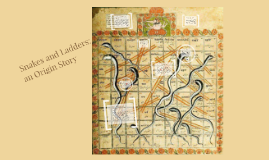Snakes and Ladders
Transcript: Why did people play this game? As said before, the purpose of the game was to differentiate between virtue and evil. Traditional Hindu philosophies were also incorporated into the game, such as karma and kama (destiny and desire). It was used as a lesson for children so that they could learn about God and what was considered virtuous. There were moral teachings behind this origin of this game. These teachings encompassed the idea that there was the ability to attain salvation through doing good, whereas performing evil deeds will provide evil rebirth. Snakes and Ladders: an Origin Story Conflicts of Snakes and Ladders The game, as said before, was developed mainly to serve the purpose of teaching children the virtues and evils of the world. Why did people play Snakes and Ladders? The Continuity and Changes of Snakes and Ladders Saint Gyandev/ Dnyaneshwar The first play of Snakes and Ladders was recorded in the thirteenth century AD when it was invented. However, it is believed that Snakes and Ladders was played dating all the way back to the second century BC in the Northern regions of India. Though there is not any significant conflict that was marked in history as a prominent event, there still was the fact that Europe stole the whole “snakes and ladders” idea and made it their own. Around the time that this idea was diffused, Indian was under British rule and tensions were already high. The fact that their virtuous game was turned into something western just increased tensions and made the British rulers more susceptible to rebellion. When and where was Snakes and Ladders first played? The game “snakes and ladders” was invented by Saint Gyandev. The fact that he was a saint alludes to the whole purpose of the board game, which it about differentiating between virtue and evil. From being used in the second century BC, the game has evolved by diffusing all across the globes, with certain cultures adding their adaptations to it. A rather large example is in Europe, where the adopted the name of “Chutes and Ladders” which is how we know it today. This was developed in 1892, where the common Victorian Philosophies were incorporated. The ladders represented thrift, penitence, and industry which would build up to squares of fulfillment, grace, and success. The snakes (which were later turned into chutes) were a representation of indulgence, disobedience, and indolence which would cause illness, disgrace and poverty. Who invented Snakes and Ladders? Why was the game developed? This game was popular to children of all backgrounds. However, those of the lower class typically could not afford the game, so there would be much less playing in those classes than in the others. Those in the Brahman class were more likely to play and pass on the message to their children.

















